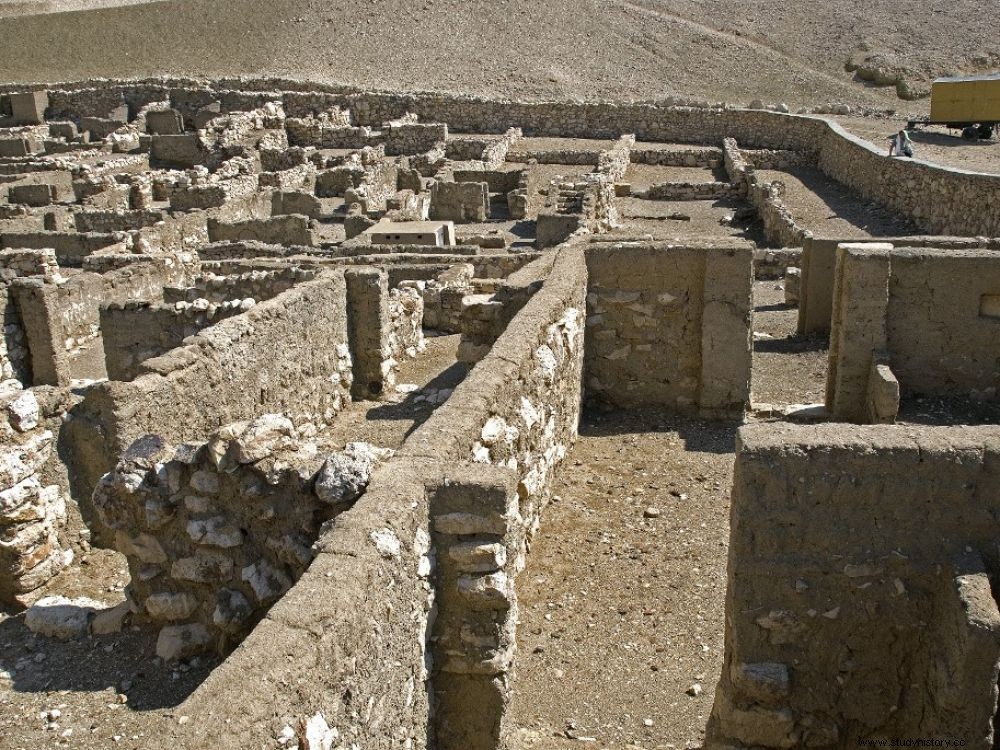The "village" of Deir el-Medina housed the workers of the funeral sites as well as their families. The archaeologists were able to reconstruct their daily life... right down to the reasons for their work stoppages!

Overview of the walls of the houses of the craftsmen's village of Deir el Medina (Deir el-Medina) in Egypt.
This article is from the Special Issue of Sciences et Avenir n°197 dated April-May 2019.
Guillemette Andreu-Lanoë is an Egyptologist, Honorary Director of the Department of Egyptian Antiquities at the Louvre Museum. She answered questions from Sciences et Avenir .
Sciences et Avenir:Archaeologists have unearthed a village that housed the workers working on the funeral sites...
Guillemette Andreu-Lanoë: Deir el-Medina was not really a village, more like a camp, because there was no water point. It was founded in the New Kingdom by the Institution of the Tomb, an organization dependent on Pharaoh intended to manage the creation of the tombs of the members of the royal family and therefore directed the craftsmen. Everything necessary was delivered on site:water, food, linen... This completely artificial place, about forty minutes walk from the Valley of the Kings, was abandoned almost at the same time as the necropolis. royal, at the end of the New Kingdom.
How did it develop?
The first traces allowing to date it are cartouches engraved on the bricks of the initial enclosure wall, in the name of Thutmose I (1504-1492). In other words, long before the "episode" Akhenaten - which moved the whole team to Amarna. A dozen tombs have been identified around the village, including the superb one of Khâ, site manager under Amenhotep II, Thutmose IV and Amenhotep III. The richness of the tomb shows how important the figure was.
Deir el-Medina experienced two extensions to the Ramesside period. It is a well-documented era thanks to the many ostraca found on the site that recount the daily life of the community. From Ramses IV (1153-1147), Egypt begins a decline. The reigns are shorter, the pharaohs less prestigious and, paradoxically, the tombs increasingly vast. We then bathe in full funerary megalomania!
Who were these artisans?
This article is from the Special Issue of Sciences et Avenir n°197 dated April-May 2019.
Guillemette Andreu-Lanoë is an Egyptologist, Honorary Director of the Department of Egyptian Antiquities at the Louvre Museum. She answered questions from Sciences et Avenir .
Sciences et Avenir:Archaeologists have unearthed a village that housed the workers working on the funeral sites...
Guillemette Andreu-Lanoë: Deir el-Medina was not really a village, more like a camp, because there was no water point. It was founded in the New Kingdom by the Institution of the Tomb, an organization dependent on Pharaoh intended to manage the creation of the tombs of the members of the royal family and therefore directed the craftsmen. Everything necessary was delivered on site:water, food, linen... This completely artificial place, about forty minutes walk from the Valley of the Kings, was abandoned almost at the same time as the necropolis. royal, at the end of the New Kingdom.
How did it develop?
The first traces allowing to date it are cartouches engraved on the bricks of the initial surrounding wall, in the name of Thutmose I st (1504-1492). In other words, long before the "episode" Akhenaten - which moved the whole team to Amarna. A dozen tombs have been identified around the village, including the superb one of Khâ, site manager under Amenhotep II, Thutmose IV and Amenhotep III. The richness of the tomb shows how important the figure was.
Deir el-Medina experienced two extensions to the Ramesside period. It is a well-documented era thanks to the many ostraca found on the site that recount the daily life of the community. From Ramses IV (1153-1147), Egypt begins a decline. The reigns are shorter, the pharaohs less prestigious and, paradoxically, the tombs increasingly vast. We then bathe in full funerary megalomania!
Who were these artisans?
There are several corporations, as the papyri attest:the quarrymen (who dig the tomb), the plasterers (who prepare the walls), the painters, the sculptors, the scribes... The funerary furniture was made in workshops exteriors. For the craftsmen, working in Deir el-Medina was a consecration that gave them a special place in Egyptian society... and a title, unrelated to their function:"He who hears the call to the seat of Set- Maat ". Without being priests, they maintained a particular link with a sacred space. Set-Maât, the "place of Maât" (order, justice, truth) was not only the Valley of the Kings, but all a set also including the castles of millions of years, the tombs, the village, in which they form an aristocracy, a protected group.
How many people lived in Deir el-Medina?
By analyzing the remains, it was estimated that around sixty families occupied the premises. However, one of the censuses found in situ , in which everything is recorded, house by house, allowed us to reassess this number up to 120 families, including real dynasties. Strangely, there are quite a few children. The school, if there was one, was perhaps at the Ramesseum, a few miles away. It is assumed that most were sent elsewhere and that the craftsmen only kept with them those who were destined to follow them.
How was the work in the royal tombs?
Before going to the construction site, the craftsmen had to go through the khetem (headquarters of the Institution de la Tombe, at the exit of the village). There, they were given the ostraca or the papyrus where the work to be done was noted. In the tombs, two teams progressed simultaneously, the one on the left and the one on the right:each had its own wall… and its leader. With a competition between the two. The workers worked for ten days and then returned to the village to rest for two days. Some papyri mention the reasons for absence:vacation, service to be rendered, illness, woman or girl having her period, and even... hangover!
By Henri Morel
